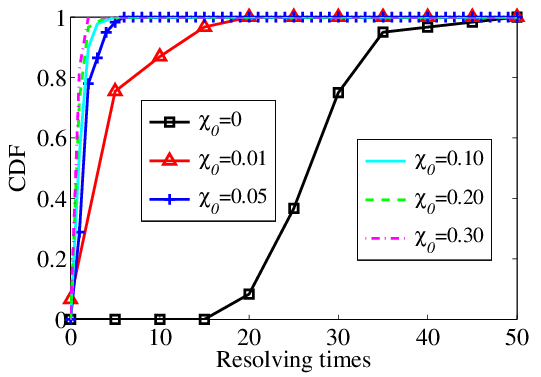这篇 blog 将展示用 matlab 计算并画出大量数据的 CDF (累计分布函数)的两种方法。第一种是我自己于2012年写的,后来用的过程中发现有缺陷;后来2014年写另一篇paper时,搜寻到第二种简易又高效的方法。这里我给出它们各自的用例,包括画图用的数据与脚本,以及效果图。For your reference.
============================================================================================
Section A. 第一种方法
今天(2012-10-17)有一些数据需要处理,这些数据好不容易从文件中剥离了出来,然后自己写了一个function,计算并控制 plot 这些数据的 CDF 图。因为第一种方法用到的例子的数据文件太大,就没有贴上来。如果有想亲自试验一下这个过程的同学,请参照下文中第二个方法中的完整用例。
% ----------------------- 自实现 CDF 计算 function: funcCDF.m
- % para@1: CNT_pnts, the number of points to denote the CDF;
- % para@2: Range_low, the lower bound of variable;
- % para@3: Range_up, the upper bound of variable;
- % para@4 : arr_Vals, array of the values to be processed.
- function [x, CDF_Vals] = funcCDF(CNT_pnts, Range_low, Range_up, arr_Vals)
- data = sort( arr_Vals' ); % T', horizon arrays of T.
- N = length(data);
- stepLen = (Range_up-Range_low)/CNT_pnts;
- Counter = zeros(1,CNT_pnts);
- for i = 1:1:N
- for j = 1:1:CNT_pnts
- if ( data(1,i) <= (Range_low + j*stepLen) )
- Counter(1,j) = Counter(1,j) + 1;
- end
- end
- end
- CDF = Counter(1,:)./N;
- CDF_Vals = CDF(1,:)';
- x = (Range_low+stepLen):stepLen:Range_up;
- % ---- end of func.
% --------------------- 2 use cases:
- CNT_pnts = 100;
- deadline_N500r1 = 550;
- deadline_N500r3 = 270;
- deadline_N500r5 = 240;
- PntVal_N500Tau100r1 = textread('N500Tau100r1.tr','%*s %*s %*s %*s %*s %*s %*s %*s %*s %*s %*s %.2f');
- [x_r1,cdf_r1] = funcCDF(CNT_pnts, 0, deadline_N500r1, PntVal_N500Tau100r1);
- plot(x_r1, cdf_r1, 'ob')
- hold on
- PntVal_N500Tau100r3 = textread('N500Tau100r3.tr','%*s %*s %*s %*s %*s %*s %*s %*s %*s %*s %*s %.2f');
- [x_r3,cdf_r3] = funcCDF(CNT_pnts, 0, deadline_N500r3, PntVal_N500Tau100r3);
- plot(x_r3, cdf_r3, 'or')
- hold on
- PntVal_N500Tau100r5 = textread('N500Tau100r5.tr','%*s %*s %*s %*s %*s %*s %*s %*s %*s %*s %*s %.2f');
- [x_r5,cdf_r5] = funcCDF(CNT_pnts, 0, deadline_N500r5, PntVal_N500Tau100r5);
- plot(x_r5, cdf_r5, 'oc')
- grid
% --------------------- 3 效果图:
Fig.1 CDF_N200r3--Tau-60-80-100-100Pnts

Fig.2 CDF_N500Tau100--r-1-3-5-100Pnts

当把参数 CNT_pnts = 100; 调为 CNT_pnts = 50; 后,显示在图中的点就会减少一半,shows as follow:
Fig.3 CDF_N500Tau100--r-1-3-5-50Pnts

Davy_H (2012-10-17)
============================================================================================
Section B. 第二种方法
今天(2014-10-15) 回过头来看这篇blog,前边贴的图太丑,而且其实第一种方法有不完美的地方,即数据少的时候,曲线有时不会从原点开始画。后来寻到更好的方法来画 CDF 图,为了对得起2000+的访问量,所以,今日我决定花些时间,把更好的例子分享出来。
废话不多说:1)效果图;2)部分数据文件;3)画图的脚本。
1) ------------------
3) ------------------ Codes:
- clear;
- % --------------- A. Read the Data.
- X_ = textread('_Trace_file.tr','%*s%*s %*s%*s %*s%*s %*s%*s %*s%*s %*s%*s %*s%*s %*s%*s %*s%f');
- CNT_resolve_times = textread('_Trace_file.tr','%*s%*s %*s%*s %*s%*s %*s%*s %*s%*s %*s%*s %*s%*s %*s%d %*s%*s' );
- % --------------- B. Count the the Costs.
- % --------- X_items is the "-Threshold"
- X_items =[0.0,0.01,0.05,0.1,0.2,0.3];
- CNT_X = length(X_items);
- % --------- Define the range_x of the x_coordinate in the figure.
- step = 1;
- range_end = 50;
- range_x = 0:step:range_end;
- figure
- % ---------- Format of figure:
- TextFontSize=18;
- LegendFontSize = 16;
- set(0,'DefaultAxesFontName','Times',...
- 'DefaultLineLineWidth',2,...
- 'DefaultLineMarkerSize',8);
- set(gca,'FontName','Times New Roman','FontSize',TextFontSize);
- set(gcf,'Units','inches','Position',[0 0 6.0 4.0]);
- % ---------- Format of figure:~
- % ------ Plot lines
- for i = 1:1:CNT_X
- Val_item = X_items(i);
- idx_it_Lazy = find( X_ == Val_item );
- % --- 1 CNT_STimes
- CNT_Re_times_its = [];
- CNT_Re_times_its = CNT_resolve_times( idx_it_Lazy );
- % --- 2 Plot CDF of CNT_Resloving_times, i.e., the "CNT_STimes" in the trace file.
- if (i==1) linePoint_type = '-sk'; step = 5; range_x = 0:step:range_end;
- elseif (i==2) linePoint_type = '-^r';
- elseif (i==3) linePoint_type = '-+b'; step = 1; range_x = 0:step:range_end;
- elseif (i==4) linePoint_type = '-c'; step = 1; range_x = 0:step:range_end;
- elseif (i==5) linePoint_type = '--g'; step = 1; range_x = 0:step:range_end;
- elseif (i==6) linePoint_type = '-.m'; step = 1; range_x = 0:step:range_end;
- end
- %%% ====== Critical Code of CDF-Ploting :
- h_rtl = hist( CNT_Re_times_its, range_x );
- pr_approx_cdf = cumsum(h_rtl) / ( sum(h_rtl) );
- %%% ====== Critical Code of CDF-Ploting :~
- handler = plot( range_x, pr_approx_cdf, linePoint_type );
- if (i==4) h4 = handler;
- elseif (i==5) h5 = handler;
- elseif (i==6) h6 = handler;
- end
- hold on
- end
- % --------- Set the other formats of the figure :
- grid off
- axis([0 range_end 0 1.0])
- ylabel('CDF')
- xlabel('Resolving times')
- % --------- Plot the multi-legends :
- hg1=legend('{\it \chi_0}=0', '{\it \chi_0}=0.01', '{\it \chi_0}=0.05', 0);
- set(hg1,'FontSize',LegendFontSize);
- ah1 = axes('position',get(gca,'position'), 'visible','off');
- hg2 = legend(ah1, [h4,h5,h6], '{\it \chi_0}=0.10','{\it \chi_0}=0.20','{\it \chi_0}=0.30', 0);
- set(hg2,'FontSize',LegendFontSize);
- % --------- Plot the multi-legends :~
- % --------- Set the other formats of the figure :~
关键代码处,我已经做了注释,此处再强调一下:
1. 画 CDF 的2句关键代码,其中的3个 functions 请自己查询。
%%% ====== Critical operation of CDF-Ploting :
h_rtl = hist ( CNT_Re_times_its, range_x );
pr_approx_cdf = cumsum(h_rtl) / ( sum(h_rtl) );
%%% ====== Critical operation of CDF-Ploting :~
2. for 循环中的那一段 if else 语句,是为了设置各条曲线的点线型( linePoint type ) 与 各条线上的取样点的密度。
3. 此外,从这个脚本里,也可以额外获取画多个图例 (plot multiple legends) 的方法。
y = evrnd(0,3,100,1);
cdfplot(y);
hold on;
x = -20:0.1:10;
f = evcdf(x,0,3);
plot(x,f,'m');
legend('Empirical','Theoretical','Location','NW')











 本文详细介绍了使用Matlab计算并绘制CDF(累计分布函数)的两种方法,包括自定义实现与改进后的高效方法,并提供了完整的用例及绘图示例。
本文详细介绍了使用Matlab计算并绘制CDF(累计分布函数)的两种方法,包括自定义实现与改进后的高效方法,并提供了完整的用例及绘图示例。

















 2万+
2万+

 被折叠的 条评论
为什么被折叠?
被折叠的 条评论
为什么被折叠?








